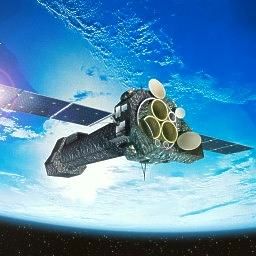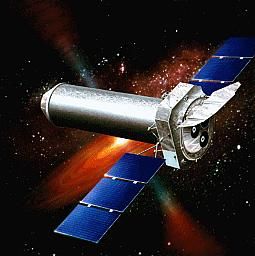
Home - Search - Browse - Alphabetic Index: 0- 1- 2- 3- 4- 5- 6- 7- 8- 9
A- B- C- D- E- F- G- H- I- J- K- L- M- N- O- P- Q- R- S- T- U- V- W- X- Y- Z
XMM
 XMM |
AKA: XMM-Newton;X-ray Multi Mirror. Status: Operational 1999. First Launch: 1999-12-10. Last Launch: 1999-12-10. Number: 1 . Gross mass: 3,800 kg (8,300 lb). Height: 10.00 m (32.00 ft). Span: 16.00 m (52.00 ft).
The XMM was a three-axis stabilized spacecraft with a pointing accuracy of 1 arcsec. The satellite consisted of a service module bearing the X-ray Mirror Modules, propulsion and electrical systems, a long telescope tube, and the focal plane assembly carrying the science instruments. The Prime contractor was DaimlerChrysler Aerospace Dornier Satellitensysteme, Friedrichshafen, Germany; subcontractors included 46 companies from 14 European countries and one in the United States. Media Lario, Como, Italy, developed the X-ray Mirror Modules.
XMM was designed to operate for 10 years. The telescope consisted of three barrel-shaped Mirror Modules, each containing 58 "Wolter-type" wafer-thin concentric mirrors, 0.3 m to 0.7 m in diameter and 0.6 m in length. The total collecting area was 4300 cm2 at 1.5 keV, 1800 cm2 at 8 keV. The focal length of the telescope was 7.5 m and resolution was 5 arcsec (full width half-maximum), 14 arcsec (half energy width) at all wavelengths. Each X-ray Mirror Module had a mass of 500 kg.
The main science instruments on board XMM included:
- The three European Photon Imaging Cameras (EPIC) produced by a consortium made up of 10 Institutes in four nations: the UK, Italy, France and Germany. EPIC Principal Investigator was Prof. Martin Turner of the X-ray Astronomy Group at Leicester University, UK. One of the cameras used a new type of CCD (PN) developed by the Max Planck Institute of extraterrestrial Physics in Garching, Germany.
- The two Reflection Grating Spectrometers (RGS). The Principal Investigator was Prof. Bert Brinkman of the High-Energy Astronomy division SRON, Utrecht Netherlands with co-Investigator Steven KAHN from Columbia University, NY. USA
- The Optical Monitor, co-aligned with the main X-ray telescope, would give the XMM mission a multi-wavelength capacity. The Mullard Space Science Laboratory (MSSL) UK supplied this 30-cm aperture Ritchey-Chretien telescope (with a 170-600 nanometer spectral range). OM Principal Investigator was Prof. Keith Mason.
The XMM spacecraft was placed in a 48-hour elliptical orbit around the Earth (7,000 km x 114,000 km at 40 degree inclination). On each orbit, after the satellite passed through the Earth's radiation belts, astronomers had the observatory at their disposal for some 40 hours.
The XMM spacecraft was controlled by the European Space Operations Centre (ESOC, Darmstadt Germany) using ground stations at Perth (Australia) and Kourou (French Guiana). The XMM Science Operations Centre situated at VILSPA in Villafranca, Spain, managed observation requests and received XMM data. The XMM Survey Science Centre (SSC), at Leicester University UK, processed, archived and correlated all XMM observations with existing sky data held elsewhere in the world.
The XMM mission was the second Cornerstone mission of ESA's Long-Term Space Science program. It was proposed by the Agency's Science Program Committee in 1984 and was approved by the ESA Council of Ministers held in Rome in January 1985. After the setting up in January 1993 of the XMM Project team based at the ESTEC Technical Centre in Noordwijk, Netherlands, and selection of the prime contractor in October 1994, the development phase began in March 1996 and actual construction of the spacecraft started in March 1997. Satellite integration and testing was completed in September 1999. The project, under direct ESA management, was achieved within the allocated budget of 689 Million Euro at 1999 economic conditions (covering satellite design and construction, launch by Ariane-5 and science mission operations during the first two years.)
More at: XMM.
Family: Astronomy, High earth orbit, X-ray astronomy satellite. Country: Europe. Launch Vehicles: Ariane 5, Ariane 5G. Launch Sites: Kourou, Kourou ELA3. Agency: ESA. Bibliography: 2, 4231, 4232, 4233, 4234, 4235, 443, 552, 554, 12003, 13355.
 | XMM Credit: NASA |
 | XMM Credit: Manufacturer Image |
1985 January - .
- XMM approved by ESA - . Nation: Europe. Spacecraft: XMM. The XMM mission was the second Cornerstone mission of ESA's Long-Term Space Science programme. It was proposed by the Agency's Science Programme Committee in 1984 and was approved by the ESA Council of Ministers held in Rome..
1993 January - .
1994 October - .
1996 March - .
1997 March - .
1999 September - .
1999 December 10 - . 14:32 GMT - . Launch Site: Kourou. Launch Complex: Kourou ELA3. LV Family: Ariane 5. Launch Vehicle: Ariane 5G.
- XMM - . Mass: 3,764 kg (8,298 lb). Nation: Europe. Agency: ESA. Manufacturer: Friedrichshafen. Class: Astronomy. Type: X-ray astronomy satellite. Spacecraft: XMM. USAF Sat Cat: 25989 . COSPAR: 1999-066A. Apogee: 104,406 km (64,874 mi). Perigee: 16,709 km (10,382 mi). Inclination: 62.50 deg. Period: 2,872.40 min. ESA's X-ray Multi-Mirror space observatory was the biggest science satellite ever built in Europe. Complementary in characteristics to NASA's Chandra satellite, the spacecraft were expected to make major new astronomical discoveries..
Back to top of page
Home - Search - Browse - Alphabetic Index: 0- 1- 2- 3- 4- 5- 6- 7- 8- 9
A- B- C- D- E- F- G- H- I- J- K- L- M- N- O- P- Q- R- S- T- U- V- W- X- Y- Z
© 1997-2019 Mark Wade - Contact
© / Conditions for Use